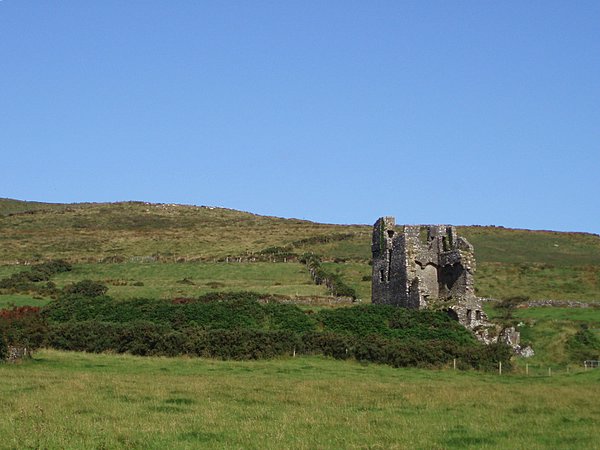Rahinnane Castle on:
[Wikipedia]
[Google]
[Amazon]
Rahinnane Castle is a
tower house
A tower house is a particular type of stone structure, built for defensive purposes as well as habitation. Tower houses began to appear in the Middle Ages, especially in mountainous or limited access areas, in order to command and defend strate ...
and National Monument
A national monument is a monument constructed in order to commemorate something of importance to national heritage, such as a country's founding, independence, war, or the life and death of a historical figure.
The term may also refer to a sp ...
located in County Kerry
County Kerry ( gle, Contae Chiarraí) is a county in Ireland. It is located in the South-West Region and forms part of the province of Munster. It is named after the Ciarraige who lived in part of the present county. The population of the cou ...
, Ireland
Ireland ( ; ga, Éire ; Ulster Scots dialect, Ulster-Scots: ) is an island in the Atlantic Ocean, North Atlantic Ocean, in Northwestern Europe, north-western Europe. It is separated from Great Britain to its east by the North Channel (Grea ...
.
Location
Rahinnane Castle is located northwest ofVentry
Ventry (), officially ''Ceann Trá'',Ventry/Ceann Trá
 The ancient earthwork featured a deep ditch, an entrance in the southwest and a
The ancient earthwork featured a deep ditch, an entrance in the southwest and a
Dingle Peninsula
The Dingle Peninsula ( ga, Corca Dhuibhne; anglicised as Corkaguiny, the name of the corresponding barony) is the northernmost of the major peninsulas in County Kerry. It ends beyond the town of Dingle at Dunmore Head, the westernmost point ...
.
History
Theringfort
Ringforts, ring forts or ring fortresses are circular fortified settlements that were mostly built during the Bronze Age up to about the year 1000. They are found in Northern Europe, especially in Ireland. There are also many in South Wale ...
on the site was built in the 7th or 8th century AD. The Irish name was originally ''Rath Fhionnáin'' — Finan's ringfort.
Local tradition once claimed that this piece of land was the last in Ireland held by the Viking
Vikings ; non, víkingr is the modern name given to seafaring people originally from Scandinavia (present-day Denmark, Norway and Sweden),
who from the late 8th to the late 11th centuries raided, pirated, traded and s ...
s, as it was so easily defended.
The stone tower house was built in the 15th or 16th century by the FitzGeralds, hereditary Knights of Kerry
Knight of Kerry (), also called The Green Knight, is one of three Hiberno-Norman hereditary knighthoods, all of which existed in Ireland since feudal times. The other two were The White Knight (surname fixed as Fitzgibbon), being dormant sinc ...
.
In 1602, towards the end of the Nine Years' War, the castle was taken by Sir Charles Wilmot
Charles Wilmot, 1st Viscount Wilmot of Athlone (c. 1572 – 1644) was an English soldier active in Ireland.
Life
He was the son of Edward Wilmot of Culham (otherwise of Newent, Gloucestershire and Witney, Oxfordshire) and Elizabeth Stafford. O ...
. It was ruined during the Cromwellian conquest (1649–53).
Building
 The ancient earthwork featured a deep ditch, an entrance in the southwest and a
The ancient earthwork featured a deep ditch, an entrance in the southwest and a souterrain
''Souterrain'' (from French ''sous terrain'', meaning "under ground") is a name given by archaeologists to a type of underground structure associated mainly with the European Atlantic Iron Age.
These structures appear to have been brought north ...
in the southeast.
The castle was rectangular and three storeys tall. Most of the outer walls remain; on the inside there is some mural stairway, traces of vaulting
In architecture, a vault (French ''voûte'', from Italian ''volta'') is a self-supporting arched form, usually of stone or brick, serving to cover a space with a ceiling or roof. As in building an arch, a temporary support is needed while ring ...
and a blind arcade
A blind arcade or blank arcade is an arcade (a series of arches) that has no actual openings and that is applied to the surface of a wall as a decorative element: i.e., the arches are not windows or openings but are part of the masonry face. It is ...
. Two corner turrets are also visible.
More than half the outer walls of the three-storey castle remain.
References
National Monuments in County Kerry Castles in County Kerry {{Ireland-castle-stub